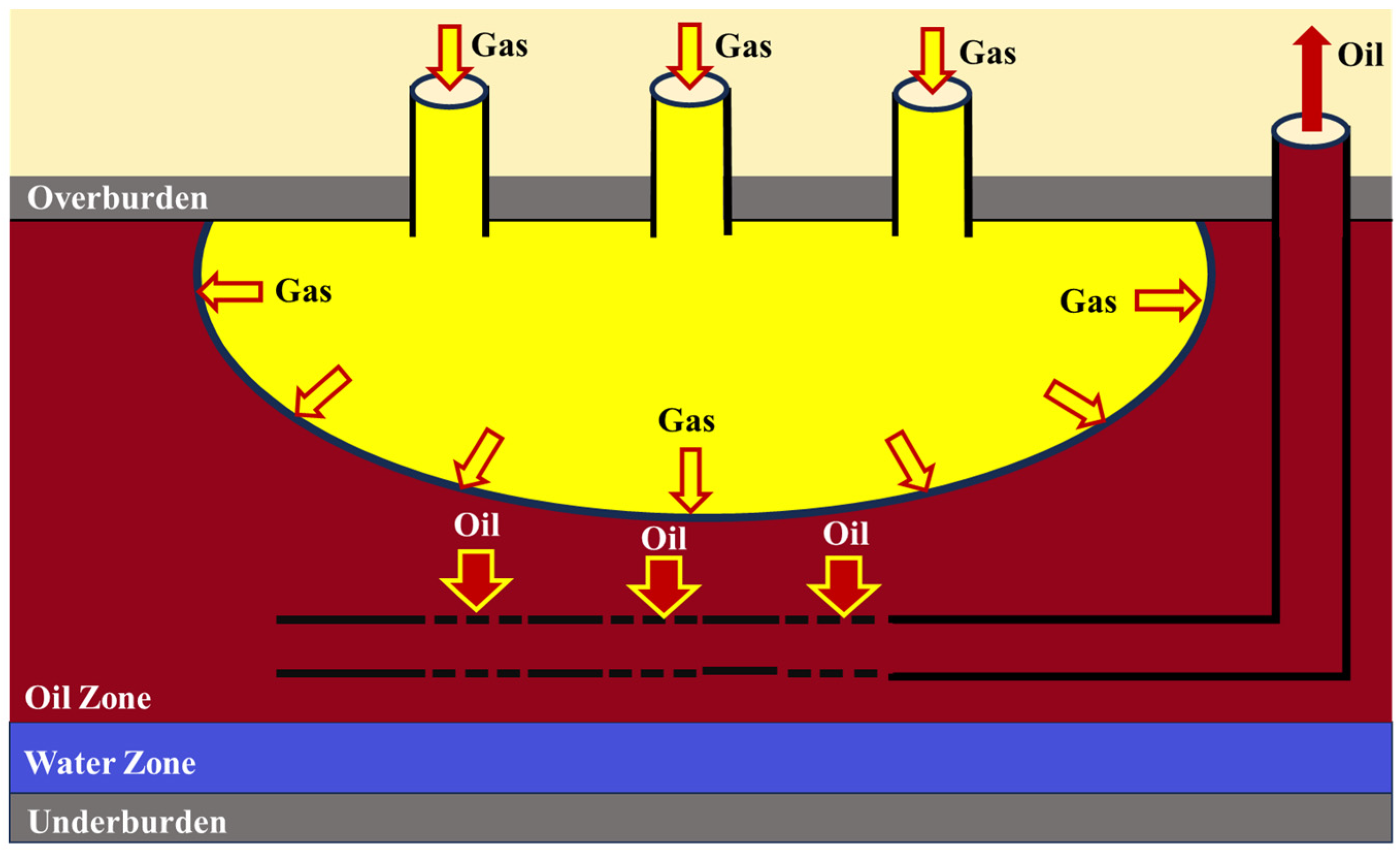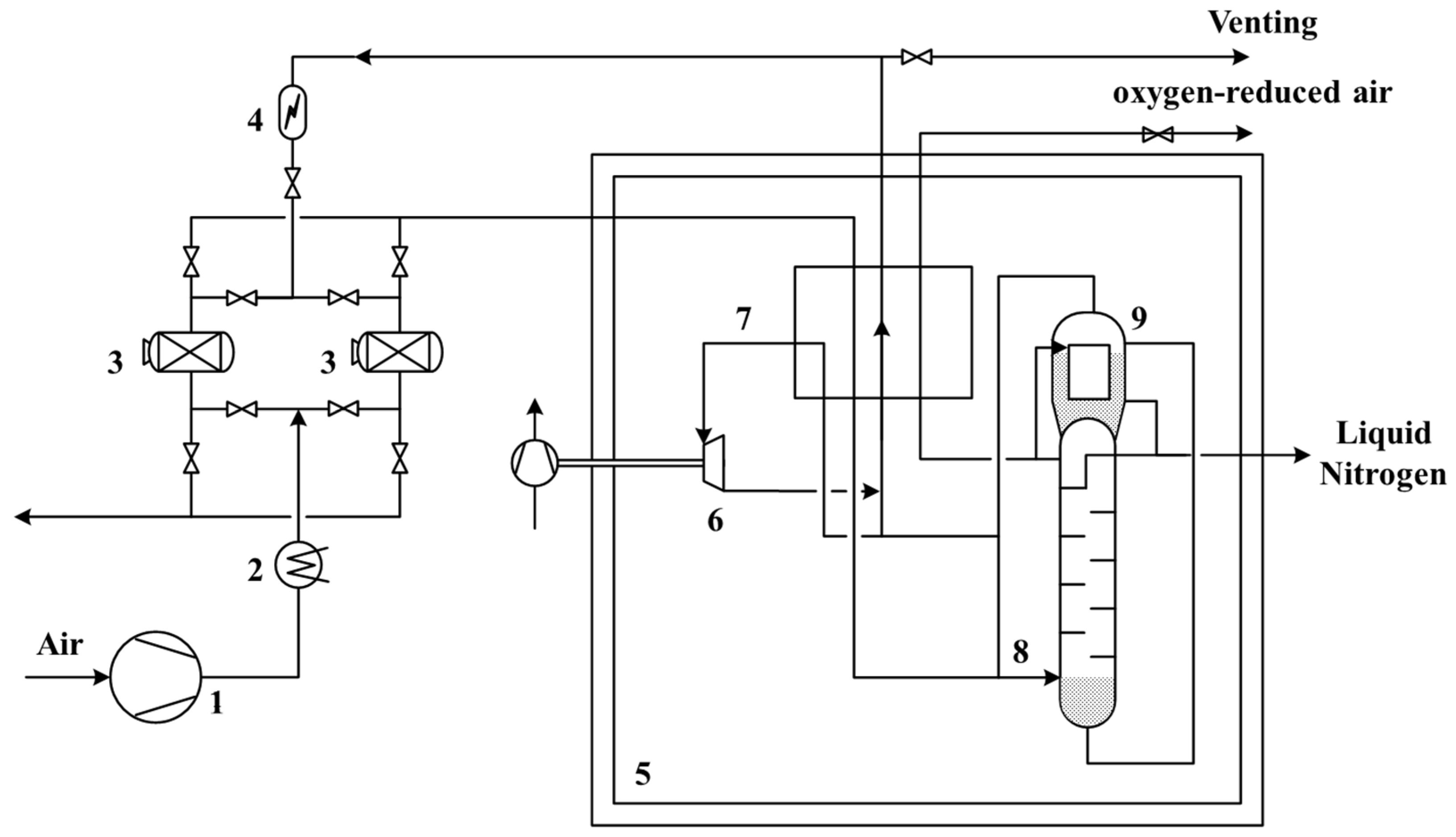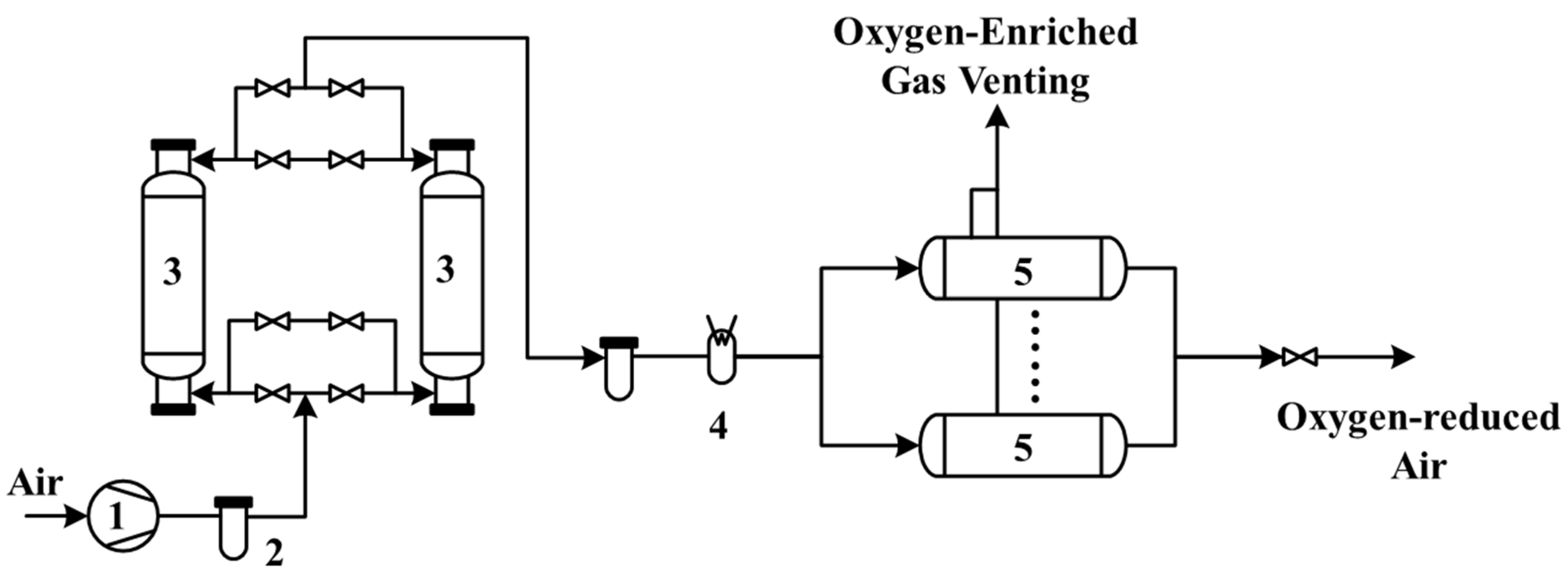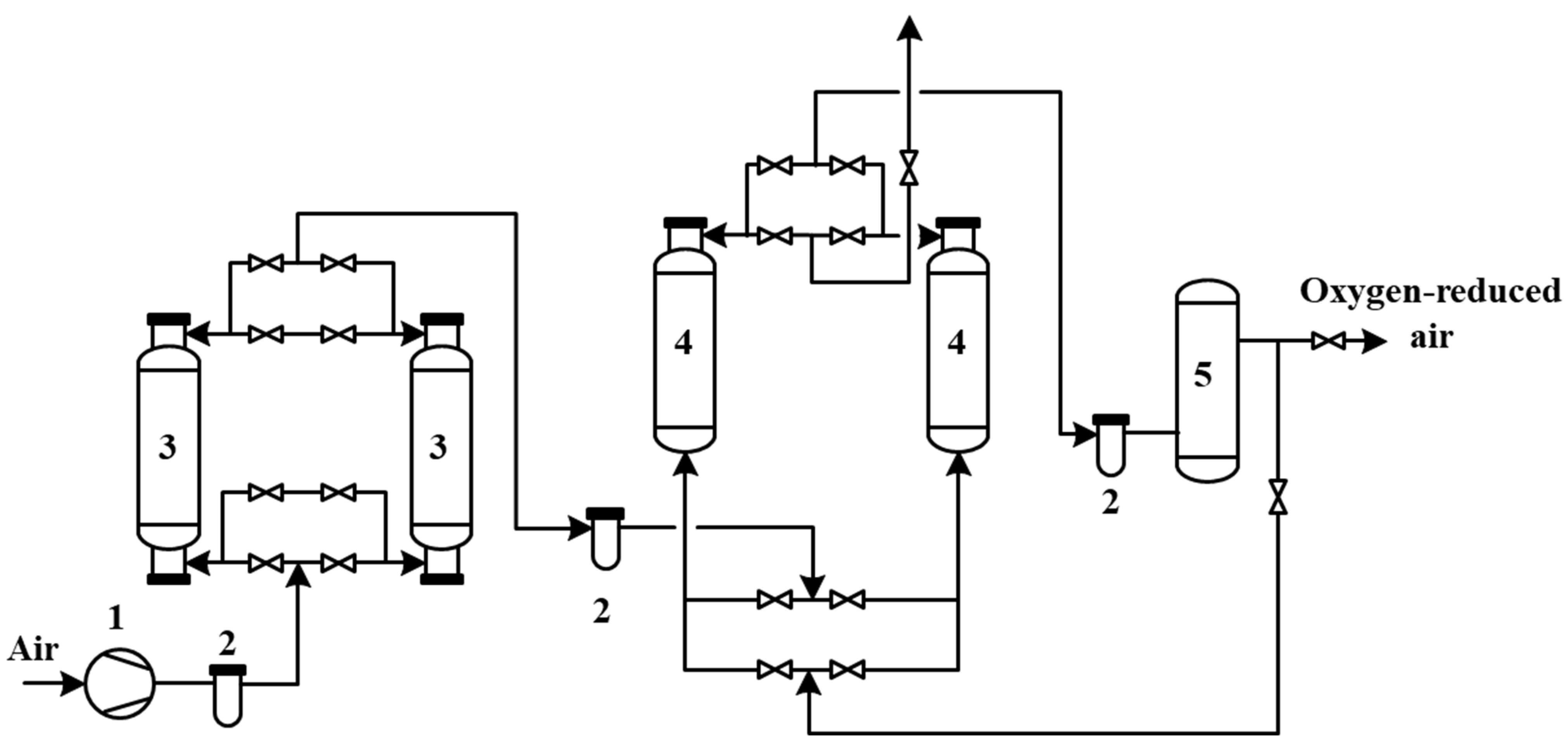Research and Application of Oxygen-Reduced-Air-Assisted Gravity Drainage for Enhanced Oil Recovery
Abstract
:1. Introduction
2. OAGD
2.1. Fundamental Principles of Oxygen-Reduced Air Gravity Drainage
2.2. Oxygen-Reduced Air Preparation Technologies
2.2.1. Cryogenic Separation
2.2.2. Membrane Separation Method
2.2.3. Pressure Swing Adsorption (PSA) Technology
2.2.4. Comparison of Oxygen-Reduced Air Preparation Processes
2.3. Field Trials in China and Internationally
2.3.1. International Field Trials
2.3.2. Field Trials in China
3. Key Factors Influencing OAGD
3.1. LTO
3.2. Injection Rate
3.3. Reservoir Inclination
3.4. Reservoir Types
4. Conclusions and Outlook
4.1. Challenges
4.2. Recommendations and Future Perspectives
4.3. Summary and Conclusions
Funding
Conflicts of Interest
Abbreviations
References
- Dakuang, H. On concepts, strategies and techniques to the secondary development of China’s high water-cut oilfields. Pet. Explor. Dev. 2010, 37, 583–591. [Google Scholar] [CrossRef]
- Han, D. Precisely predicting abundant remaining oil and improving the secondary recovery of mature oilfields. Acta Pet. Sin. 2007, 28, 73–78. [Google Scholar]
- Martirosyan, A.V.; Ilyushin, Y.V.; Afanaseva, O.; Kukharova, T.V.; Asadulagi, M.-A.M.; Khloponina, V. Development of an Oil Field’s Conceptual Model. Int. J. Eng. 2025, 38, 381–388. [Google Scholar] [CrossRef]
- Habib, S.H.; Yunus, R.; Zakaria, R.; Awang Biak, D.R.; Mohamed Jan, B.H.; Amir, Z. Chemical enhanced oil recovery: Synergetic mechanism of alkali, surfactant and polymer with overview of methyl ester sulfonate as a green alternative for EOR surfactant. Fuel 2024, 363, 130957. [Google Scholar] [CrossRef]
- Zhao, M.; Liu, K.; Meng, X.; Ma, Z.; Dai, C. Review on principles, influence and applications of nanomaterials in enhancing oil recovery. Fuel 2024, 371, 131985. [Google Scholar] [CrossRef]
- Wang, F.; Liao, G.; Su, C.; Wang, F.; Ma, J.; Yang, Y. Carbon emission reduction accounting method for a CCUS-EOR project. Pet. Explor. Dev. 2023, 50, 989–1000. [Google Scholar] [CrossRef]
- Liu, Z.-X.; Liang, Y.; Wang, Q.; Guo, Y.-J.; Gao, M.; Wang, Z.-B.; Liu, W.-L. Status and progress of worldwide EOR field applications. J. Pet. Sci. Eng. 2020, 193, 107449. [Google Scholar] [CrossRef]
- Long, A.; Qi, Q.; Chen, X.; Li, Y.; Lu, S.; Zhang, P.; Li, X. Full-Diameter Physical Simulation of Oxygen-Reducing Air Assisted Gravity Drainage:A Case Study of Gasikule E13 Reservoir in Qinghai Oilfield. Xinjiang Pet. Geol. 2021, 42, 565–571. [Google Scholar]
- Ping, G.U.O.; Zhi-wang, Y.; Guang-zhi, L. Status and enlightenment of international gas injection EOR technology. Nat. Gas Ind. 2009, 29, 92–96. [Google Scholar]
- Wang, J.; Ji, Z.; Liu, H.; Huang, Y.; Wang, Y.; Pu, Y. Experiments on nitrogen assisted gravity drainage in fractured-vuggy reservoirs. Pet. Explor. Dev. 2019, 46, 355–366. [Google Scholar] [CrossRef]
- Hu, Y.; Hao, M.; Chen, G.; Sun, R.; Li, S. Technologies and practice of CO2 flooding and sequestration in China. Pet. Explor. Dev. 2019, 46, 716–727. [Google Scholar] [CrossRef]
- Al-Mudhafar, W.J. Statistical Reservoir Characterization, Simulation, and Optimization Of Field Scale-Gas Assisted Gravity Drainage (GAGD) Process with Uncertainty Assessments. Ph.D. Dissertation, Louisiana State University, Baton Rouge, LA, USA, 2016. [Google Scholar] [CrossRef]
- Ji, Y.; Li, B.; Han, Z.; Wang, J.; Li, Z.; Li, B. Study on Flow Characteristics of Flue Gas and Steam Co-Injection for Heavy Oil Recovery. Processes 2023, 11, 1406. [Google Scholar] [CrossRef]
- Chen, C.; Tang, X.; Qin, M.; Zhou, R.; Ding, Z.; Lian, G.; Qi, H.; Chen, X.; Liu, Z.; Li, Y. Experimental Evaluation of Shale Oil Development Effectiveness by Air Injection. Energies 2022, 15, 9513. [Google Scholar] [CrossRef]
- Fassihi, M.R.; Moore, R.G.; Mehta, S.A.; Ursenbach, M.G. Safety Considerations for Air Injection into Light Oil Reservoirs. In Proceedings of the SPE Improved Oil Recovery Symposium, Tulsa, OK, USA, 12–16 April 2014. [Google Scholar]
- He, W.; He, H.; Zheng, H.; Liu, P. Experimental Study on Low-Temperature-Oxidation Parameters and Simulations of Exothermic Process during Air Injection in Light Oil Reservoirs. SPE J. 2024, 29, 4232–4247. [Google Scholar] [CrossRef]
- Ren, S.R.; Greaves, M.; Rathbone, R.R. Air Injection LTO Process: An IOR Technique for Light-Oil Reservoirs. SPE J. 2002, 7, 90–99. [Google Scholar] [CrossRef]
- Luan, J.; Dong, P.; Zheng, J. The Experimental Studies on the EOR Laws of Air Injection Displacement in the Low Permeable Oil Reservoirs. Preprints 2020, 2020020012. [Google Scholar]
- Gutiérrez, D.; Taylor, A.R.; Kumar, V.K.; Ursenbach, M.G.; Moore, R.G.; Mehta, S.A. Recovery Factors in High-Pressure Air Injection Projects Revisited. SPE Reserv. Eval. Eng. 2008, 11, 1097–1106. [Google Scholar] [CrossRef]
- Kang, W.-L.; Zhou, B.-B.; Issakhov, M.; Gabdullin, M. Advances in enhanced oil recovery technologies for low permeability reservoirs. Pet. Sci. 2022, 19, 1622–1640. [Google Scholar] [CrossRef]
- Huang, L.; Wang, Y.; Yang, Z.; Wang, Q.; Pei, S.; Zhang, L.; Ren, S. Flammability and Explosion Characteristics of Methane in Oxygen-Reduced Air and Its Application in Air Injection IOR Process. Energy Fuels 2019, 33, 11850–11860. [Google Scholar] [CrossRef]
- Chen, S. Comparison of nitrogen producing processes of pressure shift adsorption (PSA) and cryogenic separation. Mod. Chem. Ind. 2013, 33, 76–78. [Google Scholar]
- Feng, S.; Lu, J.; Liu, W.; Jiang, J.; Liu, S. Separation performance of hollow fiber membrane for on-board inerting gas generating system. J. Aerosp. Power 2012, 27, 1332–1339. [Google Scholar]
- Shu, Q.; Guo, Y.; Sun, Z.; Cong, G.; Xu, Y. Research and application of percolation mechanism in extra-low permeability oil reservoir. Pet. Geol. Recovery Effic. 2016, 23, 58–64. [Google Scholar]
- Feilong, G.U.; Lijun, Z.; Dong, C. Research and application of PSA technology. Chem. Ind. Eng. Prog. 2007, 26, 1356–1358. [Google Scholar]
- Gu, M.; Xian, X. Development of Pressure Swing Adsorption Technique. Guangzhou Chem. 2006, 31, 60–65. [Google Scholar]
- Shi, W.; Tian, C.; Ding, Z.; Han, Z.; Zhang, D. Review on Simulation, Optimization and Control of Pressure Swing Adsorption. J. Chem. Eng. Chin. Univ. 2018, 32, 8–15. [Google Scholar]
- Parrish, D.R.; Pollock, C.B.; Craig, F.F. Evaluation of cofcaw as a Tertiary recovery method, sloss field, nebraska. J. Pet. Technol. 1974, 26, 676–686. [Google Scholar] [CrossRef]
- Gillham, T.H.; Cerveny, B.W.; Fornea, M.A.; Bassiouni, Z. Low Cost IOR: An Update on the W. Hackberry Air Injection Project. In Proceedings of the SPE/DOE Improved Oil Recovery Symposium, Tulsa, OK, USA, 19–22 April 1998. [Google Scholar]
- Kumar, V.K.; Fassihi, M.R.; Yannimaras, D.V. Case History and Appraisal of the Medicine Pole Hills Unit Air-Injection Project. SPE Reserv. Eng. 1995, 10, 198–202. [Google Scholar] [CrossRef]
- Gutiérrez, D.; Miller, R.J.; Taylor, A.R.; Thies, B.P.; Kumar, V.K. Buffalo Field High-Pressure Air Injection Projects: Technical Performance and Operational Challenges. In Proceedings of the SPE Symposium on Improved Oil Recovery, Tulsa, OK, USA, 19–23 April 2008; Volume 28. [Google Scholar]
- JPT Staff. Horse creek air-injection project: An overview. J. Pet. Technol. 1998, 50, 78–80. [Google Scholar] [CrossRef]
- Kulkarni, M.M. Multiphase Mechanisms and Fluid Dynamics in Gas Injection Enhanced Oil Recovery Processes. Ph.D. Thesis, Louisiana State University, Baton Rouge, LA, USA, 2005. [Google Scholar]
- Clara, C.; Durandeau, M.; Quenault, G.; Nguyen, T.-H. Laboratory Studies for Light-Oil Air Injection Projects: Potential Application in Handil Field. SPE Reserv. Eval. Eng. 2000, 3, 239–248. [Google Scholar] [CrossRef]
- Badics, B.; Vető, I. Source rocks and petroleum systems in the Hungarian part of the Pannonian Basin: The potential for shale gas and shale oil plays. Mar. Pet. Geol. 2012, 31, 53–69. [Google Scholar] [CrossRef]
- Limón-Hernández, T.; De-la-Fuente, G.; Garza-Ponce, G.; Monroy-Hernández, M. Overview of Cantarell field development offshore Mexico. World Oil 1999, 220, 45–50. [Google Scholar]
- Chaoguang, L.U.O.; Gaofu, W.; Zuoshan, Z.; Guijun, S.U.N.; Shaomin, R.A.N. Pilot Study on Foam Assisted Miscible Gas Displacement in Block Lun 16. J. Oil Gas Technol. 2006, 28, 132–135. [Google Scholar]
- Xiao, Z.; Yang, S.; Ma, X.; Han, J.; Wang, M. Adaptability Evaluation of Nitrogen Foam Flooding After Water-Flooding in Low-Permeability Light Oil Reservoirs. Xinjiang Pet. Geol. 2020, 41, 729–734. [Google Scholar]
- Jianfen, D.U.; Ping, G.U.O.; Zhonglin, W. Laboratory research of accelerating rate calorimeter test of high-pressure air injection at light oil reservoirs. J. Southwest Pet. Institute. Nat. Sci. Ed. 2007, 29, 17–21. [Google Scholar]
- Yang, G.; Lin, Y.; Liu, J.; Bao, J. Suitability Study of Nitrogen-Foam Flood in Heavy Oil Reservoir-An example of Liaohe oilfield. Xinjiang Pet. Geol. 2004, 25, 188–190. [Google Scholar]
- Zhang, H.; Yu, X.; Ma, L.; Chen, G.; Zheng, X.; Zhan, S. Potentials of the gas flooding for jilin low-permeability oil reservoirs. Pet. Geol. Oilfield Dev. Daqing 2014, 33, 130–134. [Google Scholar]
- Bai, F.; Shen, Y.; Meng, Q.; Song, F.; Weng, Y. Field Trials of Nitrogen Injection for Enhanced Oil Recovery in Yanling Oilfield. Acta Pet. Sin. 1998, 19, 61. [Google Scholar]
- Honggang, M.I.; Xiao, L.E.I. Research on gas injection & gravity assisted stable and displacement mechanism in Weizhou12-1 oilfield. Oil Drill. Prod. Technol. 2007, 29, 28–31. [Google Scholar]
- Wu, Z.; Li, H.; Niu, Z.; Gong, S.; Guo, C.; Chen, H. Research on the Factors Influencing the Residual Resistance Coefficient of Air Foam Flooding. Oilfield Chem. 2015, 32, 511–514. [Google Scholar]
- Liao, G.; Wang, H.; Wang, Z.; Tang, J.; Wang, B.; Pan, J.; Yang, H.; Liu, W.; Song, Q.; Pu, W. Oil oxidation in the whole temperature regions during oil reservoir air injection and development methods. Pet. Explor. Dev. 2020, 47, 334–340. [Google Scholar] [CrossRef]
- Qi, H.; Li, Y.; Chen, X.; Long, A.; Wei, L.; Li, J.; Luo, J.; Sun, X.; Tang, X.; Guan, C. Low-temperature oxidation of light crude oil in oxygen-reduced air flooding. Pet. Explor. Dev. 2021, 48, 1393–1402. [Google Scholar] [CrossRef]
- Xiong, Y.; Sun, L.; Sun, L. Reasonable Velocity of N_2 Injection NOnmiscible Flooding In Tilting Multilayer Reservoir. J. Southwest. Pet. Inst. 2002, 24, 34–36. [Google Scholar]
- Luo, F.Q.; Wang, Q.Y.; Geng, W.S.; Hou, J.; Zou, N.A.; Tan, J. Establishment of Stability Evaluation Criteria for the Oil-Gas Interface during Gas-Cap Gravity Flooding in Oil Reservoirs with Strong Edge-Water Drive. Acs Omega 2023, 8, 14915–14925. [Google Scholar] [CrossRef] [PubMed]
- Tong, K.; Liu, H.; Zhang, Y.; Wang, J.; Ge, L.; Dai, W.; Hong, C.; Meng, Q. Three-dimensional physical modeling of waterflooding in metamorphic fractured reservoirs. Pet. Explor. Dev. 2015, 42, 538–544. [Google Scholar] [CrossRef]
- Jiang, Y.; Zhang, Y.; Liu, S.; Guan, W.; Chen, Y.; Liu, S. Displacement mechanisms of airection in low permeability reservoirs. Pet. Explor. Dev. 2010, 37, 471–476. [Google Scholar]
- Jia, H.; Sheng, J.J. Numerical modeling on air injection in a light oil reservoir: Recovery mechanism and scheme optimization. Fuel 2016, 172, 70–80. [Google Scholar] [CrossRef]
- Wang, L.; Wang, T.; Bai, Z.; Yuan, C.; Song, W.; Chen, Y.; Wang, J. Thermo-oxidative behavior and kinetics analysis of light and heavy oils based on TG, DSC, and FTIR. Geoenergy Sci. Eng. 2023, 223, 211525. [Google Scholar] [CrossRef]
- Kok, M.V.; Gul, K.G. Thermal characteristics and kinetics of crude oils and SARA fractions. Thermochim. Acta 2013, 569, 66–70. [Google Scholar] [CrossRef]
- Chen, X.Y.; Ba, Z.C.; Lu, Z.Y.; Gao, Y.H.; Zhou, Y.; Li, X.R. Evaluation of low-temperature oxidation analysis and the development effect of high-pressure air injection in low-permeability reservoirs. Front. Earth Sci. 2024, 12, 1416824. [Google Scholar] [CrossRef]
- Zhao, S.; Pu, W.; Peng, X.; Zhang, J.; Ren, H. Low-temperature oxidation of heavy crude oil characterized by TG, DSC, GC-MS, and negative ion ESI FT-ICR MS. Energy 2021, 214, 119004. [Google Scholar] [CrossRef]
- Turta, A.T.; Singhal, A.K. Reservoir engineering aspects of oil recovery from low permeability reservoirs by air injection. In Proceedings of the SPE International Oil and Gas Conference and Exhibition in China, Beijing, China, 2–6 November 1998. [Google Scholar] [CrossRef]
- Hou, S.; Liu, Y.; Yu, H.; Niu, B.; Ren, S. Kinetics of low temperature oxidation of light oil in air injection process. J. China Univ. Petroleum. Ed. Natrual Sci. 2011, 35, 169–173. [Google Scholar]
- Zheng, W.K.; Li, Z.Y.; Huang, H.; Cao, X.P.; Wu, G.C.; Wang, J.; Kang, H. Evaluation and improvement of CO2 assisted gravity drainage for enhanced oil production in China. Energy Rep. 2023, 10, 4465–4473. [Google Scholar] [CrossRef]
- Hasanzadeh, M.; Madani, M. Deterministic tools to predict gas assisted gravity drainage recovery factor. Energy Geosci. 2024, 5, 100267. [Google Scholar] [CrossRef]
- Bautista, E.V.; Barillas, J.L.M.; Dutra, T.V.; da Mata, W. Capillary, viscous and gravity forces in gas-assisted gravity drainage. J. Pet. Sci. Eng. 2014, 122, 754–760. [Google Scholar] [CrossRef]
- Feng, K.; Mu, L.; Yan, Y.; Wu, Z.; Li, Q.; Zhang, Y. Numerical simulation of the enhanced oil recovery by gas-assisted gravity drainage (GAGD). Pet. Geol. Oilfield Dev. Daqing 2020, 39, 77–86. [Google Scholar]
- Ren, S.; Liu, Y.; Zhang, L.; Cui, G.; Gong, Z.; Wang, Y.; Han, B. Gravity assisted gas injection:assessment model and experimental study. J. China Univ. Petroleum. Ed. Natrual Sci. 2018, 42, 59–66. [Google Scholar]
- Zhou, W.; Zhang, J.; Tang, Y.; Chai, X.; Zhou, Y. Application of Top Gas Injection-Assisted Gravity Drainage in Bottom Water Reservoirs. J. Southwest Pet. Univ. Sci. Technol. Ed. 2017, 39, 92–100. [Google Scholar]
- Qasem, F.H.; Nashawi, I.S. Simulation and performance prediction of partially naturally fractured reservoirs under solution gas drive primary recovery and gas injection processes. J. Pet. Explor. Prod. Technol. 2024, 14, 1259–1282. [Google Scholar] [CrossRef]
- Mohammed, N.; Abbas, A.J.; Enyi, G.C.; Edem, D.E.; Suleiman, S.M. Enhanced gas recovery by nitrogen injection: The effects of injection velocity during natural gas displacement in consolidated rocks. J. Nat. Gas Sci. Eng. 2020, 83, 103513. [Google Scholar] [CrossRef]
- Xiao, Z.; Qi, H.; Zhang, Y.; Li, Y.; Yao, S.; Liu, T. Characteristics and Influencing Factors of Natural Gas Gravity Drainage in Sanjianfang Formation Reservoir of Pubei Oilfield. Xinjiang Pet. Geol. 2023, 44, 334–340. [Google Scholar]
- Chen, X.; Li, Y.; Liao, G.; Zhang, C.; Xu, S.; Qi, H.; Tang, X. Experimental investigation on stable displacement mechanism and oil recovery enhancement of oxygen-reduced air assisted gravity drainage. Pet. Explor. Dev. 2020, 47, 780–788. [Google Scholar] [CrossRef]
- Rostami, B.; Pourafshary, P.; Fathollahi, A.; Yassin, M.R.; Hassani, K.; Khosravi, M.; Mohammadifard, M.; Dangkooban, A. A new approach to characterize the performance of heavy oil recovery due to various gas injection. Int. J. Multiph. Flow 2018, 99, 273–283. [Google Scholar] [CrossRef]
- Zhang, L.; Li, H.; Wu, H.; Wang, Y.; Liu, H. Fluid and Development Characteristics of Near Critical Oil and Gas Reservoirs with High Dip Angle. Spec. Oil Gas Reserv. 2017, 24, 100–104. [Google Scholar]
- Jiang, Y.; Yang, J.; Chen, D. Research and application of gravity drainage in steam flooding:an example from the high-dip angle area of Qi-40 block in Liaohe oilfield. Oil Gas Geol. 2012, 33, 938–943. [Google Scholar]
- He, H.; Liu, W.; Chen, Y.; Liu, H.; Liu, H.; Luo, G. Synergistic mechanism of well pattern adjustment and heterogeneous phase combined flooding on enhancing oil recovery in mature fault-block reservoirs. J. Pet. Explor. Prod. Technol. 2022, 12, 3387–3398. [Google Scholar] [CrossRef]
- Al-Mudhafar, W.J.; Rao, D.N. Effect of Gas Injection Pressure on the Performance of CO2-Assisted Gravity Drainage Process in Heterogeneous Clastic Reservoirs. In Proceedings of the SPE Asia Pacific Oil and Gas Conference and Exhibition, Brisbane, Australia, 23–25 October 2018. [Google Scholar]
- Han, H.; Chen, X.; Ji, Z.; Li, J.; Lv, W.; Zhang, Q.; Gao, M.; Kang, H. Experimental characterization of oil/gas interface self-adjustment in CO2-assisted gravity drainage for reverse rhythm reservoir. Energies 2022, 15, 5860. [Google Scholar] [CrossRef]
- Lei, M.; Qu, Y.; Wan, C.; Yang, B.; He, D.; Ma, G.; Gong, X. Analysis of Influencing Factors on the Development Effect of CO2 Assisted Gravity Flooding. Spec. Oil Gas Reserv. 2022, 29, 133–140. [Google Scholar]
- Douglas, J.L.; Weiss, M. Wizard lake—reservoir quality as a key to successful miscible displacement. J. Can. Pet. Technol. 1991, 30, 86–94. [Google Scholar] [CrossRef]
- Gunawan, S.; Caié, D. Handil field: Three years of lean-gas injection into waterflooded reservoirs. Spe Reserv. Eval. Eng. 2001, 4, 107–113. [Google Scholar] [CrossRef]
- Tao, X.; Li, M.; Jia, J.; Ma, D.; Zhang, L. Geochemical Characteristics of Natural Gases and Type Study of Donghe Sandstone Reservoir,Hadexun Oilfield in Tarim Basin. Nat. Gas Geosci. 2014, 25, 70. [Google Scholar]











| Comparison Criteria | Cryogenic Separation | Membrane Separation | PSA |
|---|---|---|---|
| Process complexity | Complex process, more equipment, and long flow paths | Simpler than PSA, with no switching valves | Simple process with less equipment |
| Start/stop flexibility | Low flexibility, with 12 h to start and 24 h to shut down | High flexibility and short start-up time | Flexible, with rapid start-up/shutdown |
| Nitrogen purity efficiency | Highest efficiency for high-purity nitrogen; suitable for >99% purity | Similar to PSA, efficiency decreases above 99% | Higher efficiency below 97%; efficiency decreases above 99% |
| Air compression requirement | Medium pressure requirements | Higher pressure requirements | Medium pressure requirements |
| Product pressure stability | Stable output pressure | Stable output pressure | Requires buffer tank for pressure stabilization |
| Investment cost | High equipment and land requirements; high investment cost | Membrane components are expensive; high investment | Low initial investment cost |
| Year | Field | Trial Results | Significance |
|---|---|---|---|
| 1963–1966 | Nebraska Sloss [28] | Increased oil production by over 1 million barrels. | Demonstrated the effectiveness of air injection in EOR in water-flooded reservoirs. |
| 1971–1982 | W. Heidelberg [29] | Recovery factor improved from 6% to 30%. | Validated the feasibility of air and flue gas injection in high-temperature deep reservoirs. |
| 1977 | BRRU [30] | Recovery factor improved to 21%; cumulative production increased by over 15%. | Highlighted the potential of high-pressure air injection in low-permeability, high-pressure reservoirs. |
| 1987–1994 | MPHU [31] | Recovery factor increased from 15% to 28.2%; gas-to-oil ratio reached 1182.62 m3/t. | Demonstrated the significant enhancement in recovery for low-yield reservoirs. |
| 1996 | Horse Creek [32] | Increased production by 1 million tons; recovery factor improved by over 10%. | Showcased excellent economic and recovery performance of high-pressure air injection for further promotion. |
| Year | Field | Injection Method | Significance |
|---|---|---|---|
| 1965 | America [33] | Top–down gas injection | Conducted the first vertical gravity-stable gas injection field trial, establishing a foundation for subsequent studies. |
| 1995–1997 | Handil Main Zone [34] | Top–down non-miscible dry gas injection | Doubled oil recovery compared to water flooding, reaching 59.2%. Laboratory studies showed a 24% increase in displacement efficiency. |
| 1981–1992 | Nagy Lengyel [35] | Gas injection | Over four years, 39.6 billion m3 of gas was injected, producing an additional 1.402 million barrels of oil. The oil–gas interface remained stable, with no gas channeling observed. |
| 2000 | Cantarell [36] | Top–down nitrogen injection | Increased oil recovery by over 5%, effectively controlling the water cut and increasing oil output. This was the first nitrogen non-miscible gas injection field trial in the region. |
| Year | Field | Trial Results | Significance |
|---|---|---|---|
| 1996 | Baise Field [37] | Cumulative production increased by 14,800 tons, with significant economic benefits. | Validated the effectiveness of air/foam-assisted water injection in controlling water and enhancing oil production. |
| 2003 | Tuha Field [38] | Oil recovery efficiency improved by 10–20% compared to water flooding under LTO. | Provided theoretical and practical support for applying air injection in complex reservoirs in Tuha Field. |
| 2007 | Zhongyuan Field [39] | Oil production increased by 12%; water cut reduced by 4%, with no gas channeling observed. | Demonstrated the effectiveness of air/foam injection in high-temperature, high-salinity heterogeneous reservoirs. |
| 2012 | Liaohe Field [40] | Annual decline rate reduced from 22% to 14.5%; cumulative oil production increased by 110,000 tons. | Successfully applied oxygen-reduced air injection technology in buried hill reservoirs, laying the groundwork for large-scale implementation. |
| 2016 | Zhejiang Field | Daily oil production increased to 2.5 tons/day; water cut decreased by 20%. | Addressed water injection challenges and enhanced recovery efficiency and output. |
| 2017 | Jilin Field [41] | Daily oil production increased by 2.2 times; water cut reduced by 3.7 percentage points. | Provided a successful case study of oxygen-reduced air injection for high water-cut, low-permeability reservoirs. |
| Year | Oilfield | Injection Method | Significance |
|---|---|---|---|
| 1994 | Yanling Oilfield [42] | Top–down nitrogen injection | Enhanced recovery by over 5%, with significant water control and oil increment effects. Conducted China’s first top–down non-miscible nitrogen injection field trial. |
| 2007 | Weizhou Oilfield [43] | Top–down gas injection | Laboratory and simulation studies confirmed the effectiveness of top–down gas injection in improving recovery. Clarified the principles for well placement of injectors and producers. |
| 2016 | Huabei Oilfield [44] | Top–down air injection | Predicted recovery improvement of over 10%, with cumulative oil production of 1.789 million tons. Ensured safe production without gas explosion risks. |
| 2024 | Qinghai Oilfield | Top–down oxygen-reduced air injection | Research confirmed that injection production coordination and pressure-controlled zonal production significantly stabilized the oil–gas interface, enhancing the gravity-stable gas injection efficiency. |
| No. | Inclination Angle (°) | Hydrocarbon Pore Volume | Displacement Efficiency Before Gas Breakthrough (%) | Final Displacement Efficiency (%) | Efficiency Improvement (%) |
|---|---|---|---|---|---|
| 1 | 0 | 0.18 | 19.08 | 31.87 | 0 |
| 2 | 30 | 0.21 | 31.95 | 41.85 | 9.98 |
| 3 | 45 | 0.24 | 39.95 | 46.80 | 14.93 |
| 4 | 60 | 0.31 | 42.21 | 50.52 | 18.65 |
| 5 | 80 | 0.35 | 44.79 | 55.64 | 23.77 |
Disclaimer/Publisher’s Note: The statements, opinions and data contained in all publications are solely those of the individual author(s) and contributor(s) and not of MDPI and/or the editor(s). MDPI and/or the editor(s) disclaim responsibility for any injury to people or property resulting from any ideas, methods, instructions or products referred to in the content. |
© 2025 by the authors. Licensee MDPI, Basel, Switzerland. This article is an open access article distributed under the terms and conditions of the Creative Commons Attribution (CC BY) license (https://creativecommons.org/licenses/by/4.0/).
Share and Cite
Wei, J.; Yu, H.; Gao, M.; Yan, P.; Tan, K.; Yan, Y.; Wei, K.; Sun, M.; Yu, X.; Chen, Z.; et al. Research and Application of Oxygen-Reduced-Air-Assisted Gravity Drainage for Enhanced Oil Recovery. Energies 2025, 18, 557. https://doi.org/10.3390/en18030557
Wei J, Yu H, Gao M, Yan P, Tan K, Yan Y, Wei K, Sun M, Yu X, Chen Z, et al. Research and Application of Oxygen-Reduced-Air-Assisted Gravity Drainage for Enhanced Oil Recovery. Energies. 2025; 18(3):557. https://doi.org/10.3390/en18030557
Chicago/Turabian StyleWei, Jiangfei, Hongwei Yu, Ming Gao, Peifeng Yan, Kesheng Tan, Yutong Yan, Keqiang Wei, Mingyan Sun, Xianglong Yu, Zhihua Chen, and et al. 2025. "Research and Application of Oxygen-Reduced-Air-Assisted Gravity Drainage for Enhanced Oil Recovery" Energies 18, no. 3: 557. https://doi.org/10.3390/en18030557
APA StyleWei, J., Yu, H., Gao, M., Yan, P., Tan, K., Yan, Y., Wei, K., Sun, M., Yu, X., Chen, Z., & Chen, Q. (2025). Research and Application of Oxygen-Reduced-Air-Assisted Gravity Drainage for Enhanced Oil Recovery. Energies, 18(3), 557. https://doi.org/10.3390/en18030557






